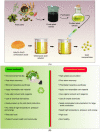Plant-Based Synthesis of Gold Nanoparticles and Theranostic Applications: A Review
- PMID: 35209180
- PMCID: PMC8875495
- DOI: 10.3390/molecules27041391
Plant-Based Synthesis of Gold Nanoparticles and Theranostic Applications: A Review
Abstract
Bionanotechnology is a branch of science that has revolutionized modern science and technology. Nanomaterials, especially noble metals, have attracted researchers due to their size and application in different branches of sciences that benefit humanity. Metal nanoparticles can be synthesized using green methods, which are good for the environment, economically viable, and facilitate synthesis. Due to their size and form, gold nanoparticles have become significant. Plant materials are of particular interest in the synthesis and manufacture of theranostic gold nanoparticles (NPs), which have been generated using various materials. On the other hand, chemically produced nanoparticles have several drawbacks in terms of cost, toxicity, and effectiveness. A plant-mediated integration of metallic nanoparticles has been developed in the field of nanotechnology to overcome the drawbacks of traditional synthesis, such as physical and synthetic strategies. Nanomaterials' tunable features make them sophisticated tools in the biomedical platform, especially for developing new diagnostics and therapeutics for malignancy, neurodegenerative, and other chronic disorders. Therefore, this review outlines the theranostic approach, the different plant materials utilized in theranostic applications, and future directions based on current breakthroughs in these fields.
Keywords: antibacterial; anticancer; antifungal; antioxidant; cytotoxicity; gold.
Conflict of interest statement
The authors declare no conflict of interest.
Figures








References
-
- Mukherjee P., Bhattacharya R., Bone N., Lee Y.K., Patra C.R., Wang S., Lu L., Secreto C., Banerjee P.C., Yaszemski M.J., et al. Potential Therapeutic Application of Gold Nanoparticles in B-Chronic Lymphocytic Leukemia (BCLL): Enhancing Apoptosis. J. Nanobiotechnology. 2007;5:4. doi: 10.1186/1477-3155-5-4. - DOI - PMC - PubMed
-
- Jamison J.A., Bryant E.L., Kadali S.B., Wong M.S., Colvin V.L., Matthews K.S., Calabretta M.K. Altering Protein Surface Charge with Chemical Modification Modulates Protein–Gold Nanoparticle Aggregation. J. Nanopart. Res. 2011;13:625–636. doi: 10.1007/s11051-010-0057-5. - DOI
Publication types
MeSH terms
Substances
LinkOut - more resources
Full Text Sources

